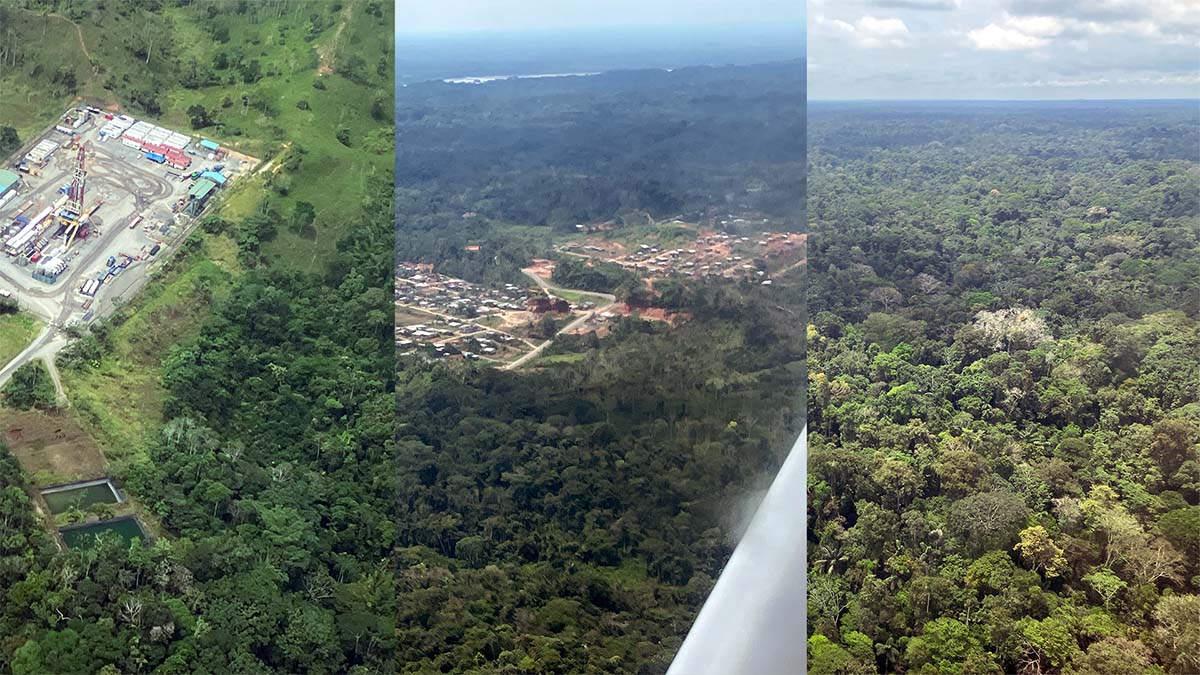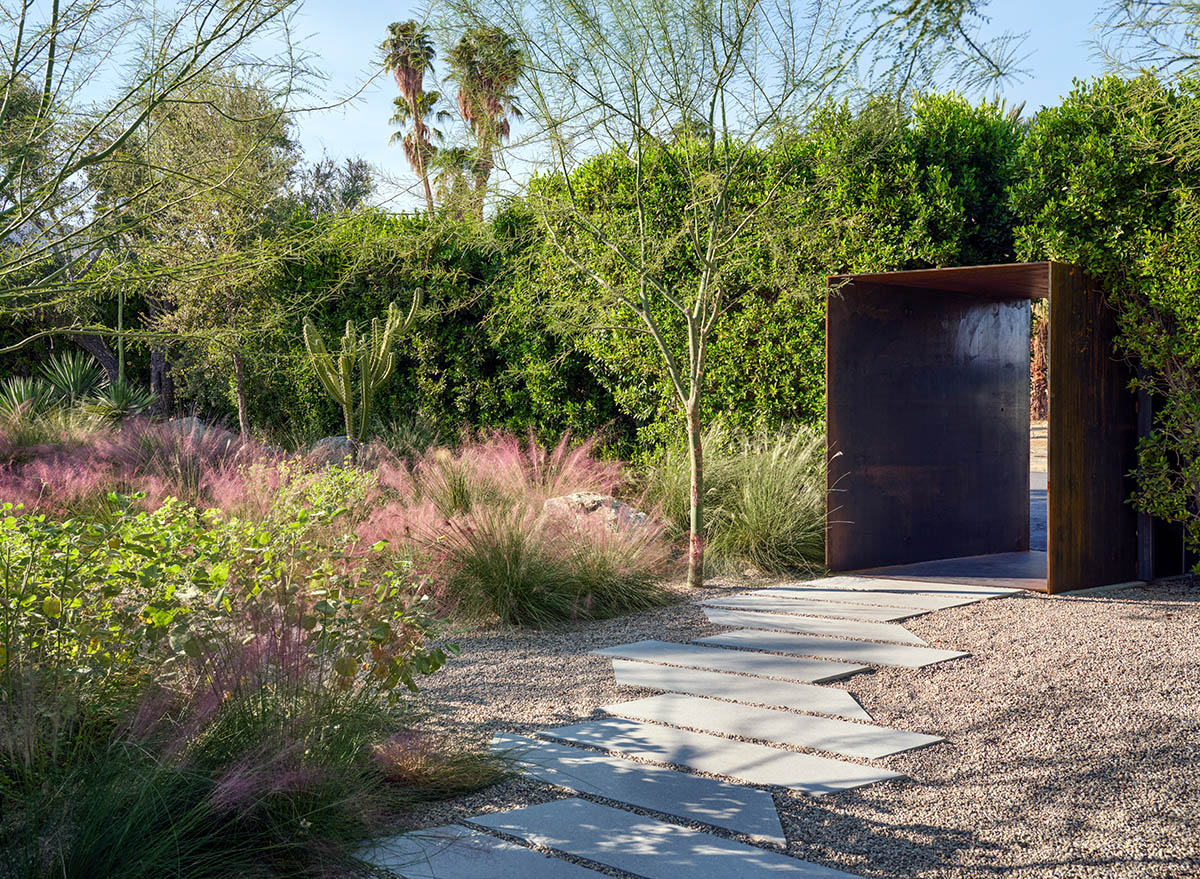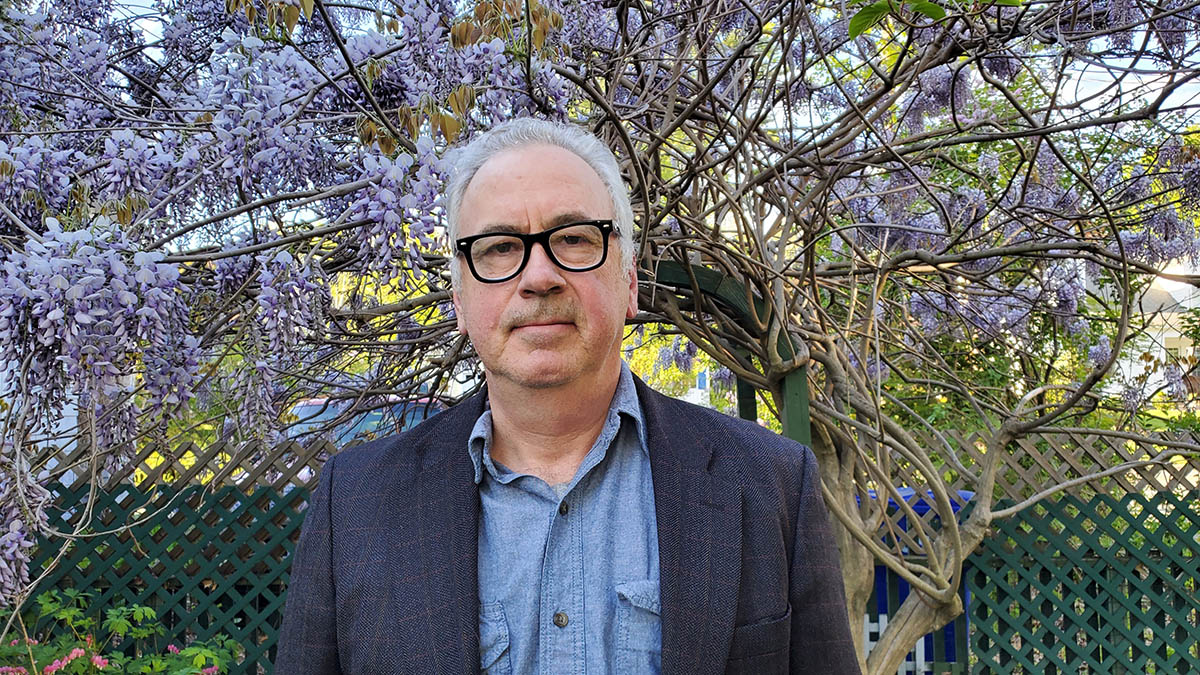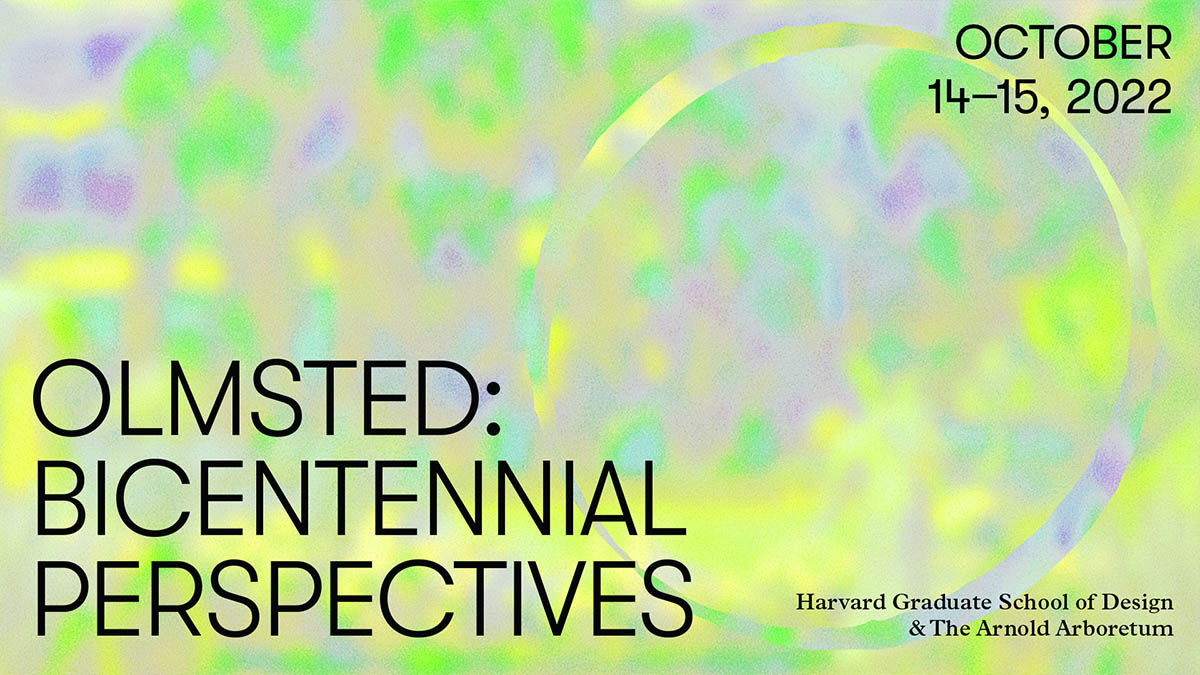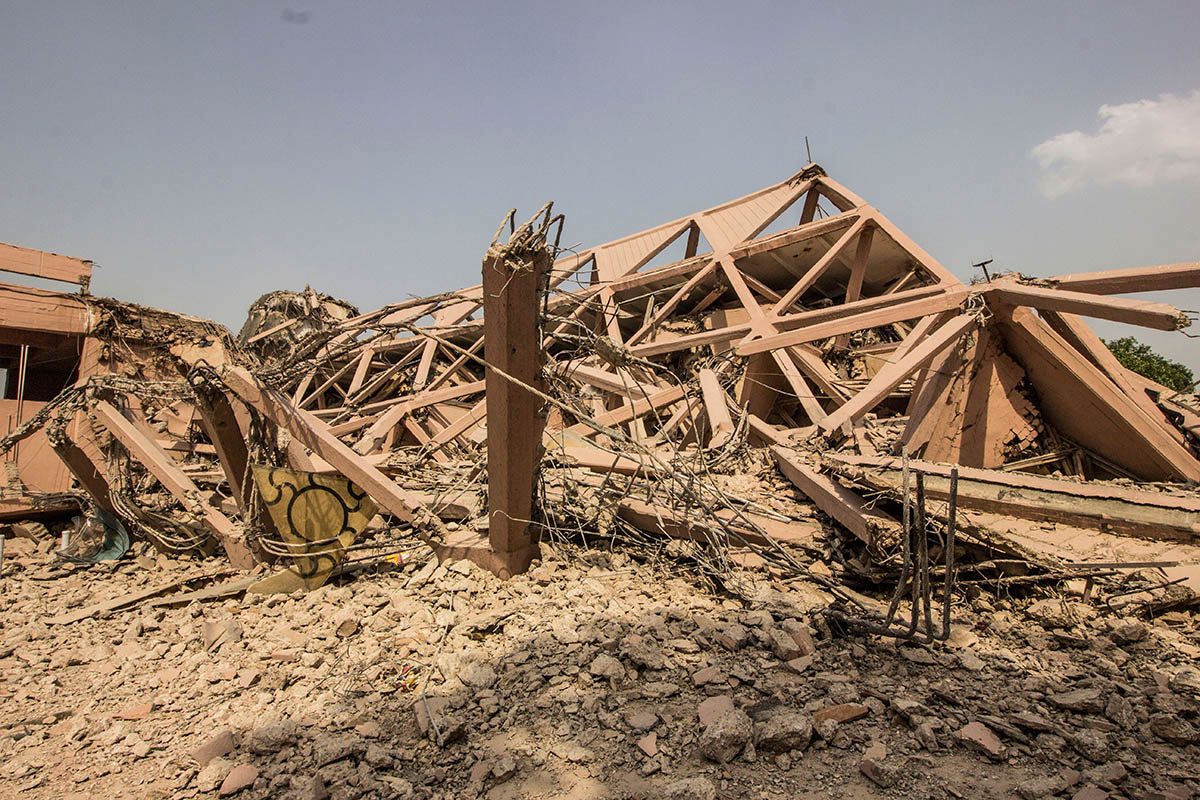Lucy Raven, “State Change and Old Gags”
Event Description
The GSD welcomes visual artist Lucy Raven to deliver the fall Rouse Visiting Artist Lecture.
In this presentation, artist Lucy Raven will present materials relating to several recent moving image installations, including Ready Mix, which was commissioned by and premiered at Dia Chelsea in 2021, and Demolition of a Wall (Album 1 and Album 2), which premiered at the 2022 Whitney Biennial and at WIELS. Together, these pieces explore the properties of extreme pressure and material state change occurring respectively at a concrete plant in central Idaho and an explosives range in southern New Mexico. They form the first two sections of a trilogy of “Westerns” Raven has been developing in locations throughout the Western United States.
For the Q+A, Raven will be joined by David Joselit , Chair of the Department of Art, Film, and Visual Studies at Harvard University.
Speaker
Lucy Raven was born in Tucson, Arizona, in 1977. She received a BFA in studio art and a BA in art history from the University of Arizona, Tucson, in 2000, and an MFA from Bard College’s Milton Avery Graduate School of the Arts, Annandale-on-Hudson, New York, in 2008. Her work has been exhibited in solo presentations at the Nevada Museum of Art, Reno (2010); Hammer Museum, Los Angeles (2012); Portikus, Frankfurt (2014); Yerba Buena Center for the Arts, San Francisco (2014); VOX centre de l’image contemporaine, Montreal (2015); Columbus Museum of Art, Ohio (2016); and Serpentine Galleries, London (2016–17). Select group shows include those at Mass MoCA, North Adams, Massachusetts (2008–09); Wexner Center for the Arts, Ohio State University, Columbus (2010); Whitney Museum of American Art, New York (2013); and Los Angeles County Museum of Art (2018–19). Additionally, Raven’s work was included in the 2012 Whitney Biennial, New York; 2016 Montreal Biennial; and 2018 Dhaka Art Summit, Bangladesh. With Vic Brooks and Evan Calder Williams, she is a founding member of 13BC, a moving-image research and production collective. Raven teaches at the Cooper Union School of Art in New York.
Ana María Durán Calisto, “The Deep History of Amazonian Agroecological Urban Forests: Why Do They Matter Today?”
A recording of this event is available with audio description .
Event Description
In this talk, Ana María Durán Calisto will discuss the design principles of ancient Amazonian agroecological urban constellations; the ways in which colonialism disrupted (and continues to disrupt) Amazonian patterns of inhabitation and habitat construction; and the visions Amazonian urban history offers to inform our ability to reimagine future urban ecologies.
Speaker
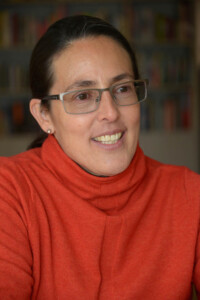
Ana María Durán Calisto is an architect, urban planner, environmental designer and scholar from Quito, Ecuador. In 2002, she founded the award-winning design group Estudio A0 with her husband, British-Punjabi architect Jaskran Kalirai. Estudio A0 has designed a diverse array of projects, at all scales, in close collaboration with its clients and community partners. Its building QPH obtained the first Leed Gold of continental Ecuador and was ranked 8th among the 500 best socio-environmental projects in Latin America at the 2015 Latin American Green Awards. In collaboration with Del Hierro AU and L + A Arquitectos, it won the competition for the Ikiam University campus, which eventually was awarded First Prize in the SDSN Amazonia Infrastructure Award, COP 21, in Paris. Its incremental housing scheme received Second Prize in a Social Housing Competition sponsored by UN Habitat. Estudio A0’s projects have been extensively published. Recent features include 30 arquitectos más relevantes de América Latina (Línea Editorial y Lexus Editores, 2020), Office Design (Booq Publishing, 2019), Company Gardens: Green Spaces for Retreat and Inspiration (Braun Publishing, 2019), and International Houses (Taschen, 2018).
Durán Calisto is currently a Ph.D. candidate in the urban planning department at UCLA. Under the advice of Susanna Hecht, she is writing a dissertation on the urban history of Amazonia, with a focus on indigenous systems of territorial planning and colonial disruptions. She is a member of the Science Panel for the Amazon, convened by SDSN & the UN. She co-authored its report ́s chapter on urbanization. In2022, she received the Mark Cousins Theory Award. Durán Calisto is a lecturer at the Yale School of Architecture and has taught research seminars and design studios at FADA-PUCE, the Harvard GSD, Columbia University, the University of Michigan, IAAC, Universidad Católica de Temuco, and UCLA ́s Institute for the Environment and Sustainability. She curated the XV Quito Architecture Biennial: Visible Cities (2006) and was National Curator for the IX BIAU. She co-edited the books Ecological Urbanism in Latin America (2019), Beyond Petropolis: Designing a Practical Utopia in Nueva Loja (2015), IV Taller Internacional de Vivienda Popular (2007).
James A. Lord and Roderick Wyllie of Surfacedesign, “Wet + Dry: Landscapes of Resilience and Material Exploration”
A recording of this event is available with audio description.
Event Description
Surfacedesign is a landscape architecture and urban design firm based in San Francisco, California. This internationally award-winning practice focuses on creating dynamic parks, campuses, plazas, waterfronts, civic landscapes and private gardens. The firm’s approach emphasizes and celebrates the unique context and imaginative potential of each project. The studio’s design process is rooted in asking novel questions and listening to a site and its users – a process that has led to engaging and inspiring landscapes that are rugged, contemporary, and crafted.
Increasingly, water has become a central focus of all landscape interventions. Holistic, systems-based design thinking that actively engages water extremes—from drought to flooding/sea level rise— is at the core of Surfacedesign’s practice. Challenging the formal manifestations of municipal guidelines and standards for water management, each project engages water as an integral design element. James and Roderick will share a range of work from the residential to the infrastructural. These works celebrate water systems and explore how planting, topography and cultural narratives can reinforce water resiliency.
Speakers

James A. Lord, FASLA
Partner, Surfacedesign Inc
James A. Lord is a founding partner of Surfacedesign, Inc. James’ innovative design approach and stewardship of the firm’s design practice has established Surfacedesign as an international leader in urban design and sustainability. He leads projects in New Zealand, Hawaii, Mexico, Los Angeles and the San Francisco Bay Area. James received his MLA from the Harvard Graduate School of Design and his BARCH from the University of Southern California.
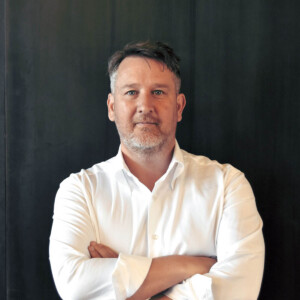
Roderick Wyllie, FASLA
Partner, Surfacedesign Inc
Roderick Wyllie is an award-winning landscape architect and a founding partner of Surfacedesign, Inc. Roderick has led a variety of complex projects within the office, including the Uber Campus in Mission Bay, San Francisco’s Bayfront Park, The Land’s End Visitor Center, The Barnacles at Pier 9 and Expedia Global Headquarters in Seattle. His horticultural knowledge and passion for material authenticity reinforce craftsmanship and attention to detail into each project at Surfacedesign.
Ethan Carr, “Letting It Alone at Franklin Park: The Good, the Bad, and the Ugly”
A recording of this event is available with audio description.
Event Description
This year’s Frederick Law Olmsted Lecture, delivered by Ethan Carr, is also the keynote lecture for the conference Olmsted: Bicentennial Perspectives, October 14-15, 2022. On Friday, the conference will run from 10:00 AM – 7:00 PM; the Frederick Law Olmsted Lecture will take place from 5:30 – 7:00 PM that evening.
“Well, they have let it alone a good deal more than I thought they would!” Horace Greeley on his first visit to Central Park (according to Clarence Cook, 1869)
“We have let it alone more than most gardeners can. But never too much, hardly enough.” Frederick Law Olmsted to Calvert Vaux, 1887
Olmsted designed his most complete and innovative park system in Boston, including a “large park” that contained his most ambitious pastoral landscape. Often grouped with Central Park (1858) and Prospect Park (1865) as one of his three greatest urban parks, Boston’s Franklin Park (1885) cost less than a third as much to develop. But the desire to “let it alone” was more than a pecuniary impulse. Achieving more by doing less culminated an evolution in his design practice. The landscape of upland pastures and hanging woods persisted as an amplified version of what it had been: a characteristic passage of “rural” New England scenery. For Olmsted, letting it alone both preserved and transformed the landscape into an ideal setting for “receptive” recreations that improved individual wellbeing and built a sense of community in the modern city.
When the problem of low visitation to Franklin Park was identified at the end of the nineteenth century, Boston responded with the construction of the Franklin Park Zoo (1912) and successfully activated the park. But in the mid-twentieth century, a decline in the condition of the park drew an opposite response—another and very different way of letting it alone. Buildings and structures were left to deteriorate and landscape maintenance all but disappeared. Institutional racism influenced official policy: once Franklin Park was perceived as a place for Black people, city government no longer considered it worth maintaining. This fact has been obscured by histories that emphasize a perceived obsolescence of the design or the conflict of “active” and “passive” recreation as causes of the park’s supposed demise. These interpretations suggest that the park should be considered an abandoned ruin awaiting redevelopment. But Franklin Park was never abandoned. For over fifty years people in the communities around it have enjoyed the park, organized programming, and performed maintenance. The official neglect of Franklin Park is nevertheless one of great inequities in the city’s history, and new investment and design must address it—perhaps by finding a right way, again, to let it alone.
To attend this keynote address, please register for Olmsted: Bicentennial Perspectives.
Speaker
Ethan Carr, PhD, FASLA, is a Professor of Landscape Architecture and the Director of the Master of Landscape Architecture program at the University of Massachusetts, Amherst. He is a landscape historian and preservationist specializing in public landscapes. Three of his award-winning books, Wilderness by Design (University of Nebraska Press, 1998), Mission 66: Modernism and the National Park Dilemma (University of Massachusetts Press, 2007), and The Greatest Beach: A History of Cape Cod National Seashore (University of Georgia Press, 2019), describe the twentieth-century history of planning and design in the US national park system as a context for considering its future. Carr was the lead editor for The Early Boston Years, 1882-1890, Volume 8 of the Papers of Frederick Law Olmsted (2013). Carr co-wrote Olmsted and Yosemite: Civil War, Abolition, and the National Park Idea (Library Of American Landscape History, 2022) with Rolf Diamant, tracing the origins of the American park movement. His latest book, Boston’s Franklin Park: Olmsted, Recreation, and the Modern City (2023) reconsiders the history of this landmark urban park. Carr consults with landscape architecture firms that are developing plans and designs for historic landscapes.
Olmsted: Bicentennial Perspectives
Event Description
The Harvard University Graduate School of Design, in partnership with the Arnold Arboretum , will host a two-day academic conference as part of the national Olmsted 200 celebration. While Olmsted was central to the conceptual formation of the degree program in landscape architecture at Harvard University and the design of the Arnold Arboretum, the interpretive ambitions of the conference are anything but parochial.
“The Sesquicentennial of a Great American.” Under that unambiguous heading, in 1972 the Olmsted Sesquicentennial Committee elaborated its “simple” reasons for celebrating the living legacy of Frederick Law Olmsted: “to dedicate ourselves to the idea of human survival and to identify this dedication with America’s first and greatest environmentalist.”
Fifty years into our ongoing act of survival, it is time again to reconsider the image of this representative American. America has changed, and so too have its (shared?) notions of greatness, of identity, and certainly its understanding of the varied historical sources of environmentalism. To what ideas do we remain dedicated in this, the year of Olmsted’s bicentennial? The story of Olmsted is perhaps no longer so simple; arguably it is more relevant than ever.
The conference consists of six panels composed of scholars from a variety of disciplines engaged in critical research on both new and familiar areas of Olmsted study. National parks, suburban subdivisions, world’s expositions, battlefields, dispossessed communities, family homesteads, English gardens, slave states, city parks, scenic parkways, forests, and swamps are but some of the sites and scenes that will be examined from a diversity of perspectives.
Register for Day 1 of the conference using this link or the link on the right-hand side of the page. In-person tickets for Day 2 are completely sold out. To engage with day 2, please watch the live stream.
Conference Overview
Friday, October 14
Harvard GSD, Piper Auditorium
48 Quincy St., Cambridge, MA 02138
Doors open at 9:30 am
Welcome
10:00 – 10:05Sarah Whiting, Dean and Josep Lluís Sert Professor of Architecture
Opening Remarks
10:05 am – 10:30 am
Edward Eigen
Panel 1: The (Un)making of America
10:30 am – 12:00 pm
Moderated by Thaisa Way
- Thomas J. Brown, The Shaw Memorial and the Boston Park System
- John D. Davis, Volunteering Olmsted
- Sara Zewde, Finding Frederick Law Olmsted in Cotton’s Kingdom
Panel 2: Campuses, Collectives, and Unsettlements
1:00 pm – 2:30 pm
Moderated by Annie Simpson
- Yvonne Elet, The Campus Green
- Christine Edstrom O’Hara, Still Chasing Water: Frederick Law Olmsted, Theory and Practice in the Arid West
- Alexander Manevitz, The Social Destruction of Seneca Village: Environmental Propaganda and the Creation of Central Park
Panel 3: …whithersoever thou goest
3:00 pm – 4:30 pm
Moderated by Sarah Moses
- Diana Martinez, Learning from Colonial Landscapes: Empire and the “Genius of Place”
- Desiree Valadares, Olmsted Across Oceans: Fred’s Maritime Voyages and Transoceanic Crossings in 1843–44
- Anette Freytag, The American Grand Tour – Fruitful Exchange Processes to Foster Democratic Spaces
Keynote Address
5:00 pm – 7:00 pm
Keynote Introduction by Gary Hilderbrand, Anticipating the Renewal of Olmsted’s Franklin Park
Ethan Carr, Letting It Alone at Franklin Park: The Good, the Bad, and the Ugly
Saturday, October 15
The Arnold Arboretum, Weld Hill Research Building
1300 Centre Street, Boston, MA 02131
Doors open at 10:00 am
Panel 1: A Clearing in the Woods
10:30 am – 12:00 pm
Moderated by Hugo Betting
- William (Ned) Friedman, Director of the Arnold Arboretum of Harvard University and Arnold Professor of Organismic and Evolutionary Biology, Arnold Arboretum at 150 – Looking Ahead to the Next Century
- Rosetta S. Elkin, Out of Place: Landscape Advocacy at the Arnold Arboretum
- Mary Kuhn, Approaching Olmsted’s Forests
Panel 2: Roads, Barriers, and Democratic Vistas
1:00 pm – 2:30 pm
Moderated by Fadi Masoud
- Sara Jacobs, Landscapes of Racialization: Visualizing Race, Nature, and Urban Landscapes after Olmsted
- Tim Davis, FLO in the Driver’s Seat: The Primacy of Roads in Olmsted’s Vision of Parks, Cities and Society
- Kathleen John-Alder, The Promised Land: Security, Democracy, and the National Mall
Panel 3: The Several Selves of Frederick Law Olmsted
3:00 pm – 4:30 pm
Moderated by Samantha Page
- Edward Eigen, Papering Over Olmsted
- Catherine Seavitt, Seeds, Grafts, and Offshoots: Olmsted on (and off) Staten Island, 1848–1857
- Charles Birnbaum, The Road to the Olmsted Renaissance
Reception
4:30 pm – 6:30 pm
Transportation and Access
Day 1 of the conference takes place at the GSD. The closest MBTA Red Line station is Harvard Square. Metered street parking is available but is extremely limited. We highly encourage guests to take public transportation.
Day 2 takes place at the Arnold Arboretum Weld Hill Research Building. Detailed instructions for getting to Weld Hill by public transportation or car are available on the Arboretum Website
. Free parking is available in the lot in the front of the Weld Hill building.
* The GSD will offer a free shuttle bus service from Gund Hall to the Arboretum. More information will be shared directly with conference registrants.
Accessibility questions? Visit the GSD’s Accessibility at Public Programs webpage to find information for Friday. Visit the Arboretum’s Accessibility webpage to find more information for Saturday. Still have questions? Email [email protected].
Speakers
Charles A. Birnbaum, FASLA, FAAR, is President and CEO of The Cultural Landscape Foundation (TCLF). Prior to creating TCLF, he spent fifteen years as coordinator at the National Park Service Historic Landscape Initiative and a decade in private practice in New York City with a focus on cultural landscapes and urban design. Birnbaum has authored and edited numerous publications including Modern Landscapes: Transition and Transformation (Princeton University Press), Shaping the American Landscape (University of Virginia Press, 2009), Design with Culture (University of Virginia Press, 2005), Preserving Modern Landscape Architecture (Spacemaker Press, 2006), and the forthcoming, Experiencing Olmsted (Timberpress, 2022). Birnbaum was a Loeb Fellow at Harvard’s GSD, and a Rome Prize recipient. He was awarded ASLA’s LaGasse Medal in 2008, President’s Medal in 2009 and the ASLA Medal (The Society’s highest honor) in 2018. He served as a Lecturer in Landscape Architecture at Harvard’s GSD (2020–); Visiting Professor, Columbia University’s Graduate School of Architecture (2011–16); and Glimcher Distinguished Professor, Ohio State University (2007). From 2010 to 2018, Birnbaum was a frequent contributor to The Huffington Post. In 2021, TCLF unveiled The Cornelia Hahn Oberlander International Prize in Landscape Architecture, a permanently endowed Prize with a $100,000 purse.
Thomas J. Brown received his education at Harvard University and has taught at the University of South Carolina since 1996. He addressed Olmsted’s work with the United States Sanitary Commission in Dorothea Dix, New England Reformer (Harvard University Press, 1998). His subsequent research has focused on Civil War remembrance. Brown is the author of Civil War Canon: Sites of Confederate Memory in South Carolina (University of North Carolina Press, 2015) and Civil War Monuments and the Militarization of America (University of North Carolina Press, 2019), which received the annual book prize of the Society of Civil War Historians. He is working on a book about the Shaw/54th Memorial, on which he has published essays in his co-edited Hope and Glory: Essays on the Legacy of the 54th Massachusetts Regiment (University of Massachusetts Press, 2001) and The Civil War in Art and Memory (National Gallery of Art, 2016).
Ethan Carr, PhD, FASLA, is a Professor of Landscape Architecture and the Director of the Master’s of Landscape Architecture program at the University of Massachusetts, Amherst. He is a landscape historian and preservationist specializing in public landscapes. Three of his award-winning books, Wilderness by Design (University of Nebraska Press, 1998), Mission 66: Modernism and the National Park Dilemma (University of Massachusetts Press, 2007), and The Greatest Beach: A History of Cape Cod National Seashore (University of Georgia Press, 2019), describe the twentieth-century history of planning and design in the US national park system as a context for considering its future. Carr was the lead editor for The Early Boston Years, 1882-1890, Volume 8 of the Papers of Frederick Law Olmsted (2013). Carr co-wrote Olmsted and Yosemite: Civil War, Abolition, and the National Park Idea (Library Of American Landscape History, 2022) with Rolf Diamant, tracing the origins of the American park movement. His latest book, Boston’s Franklin Park: Olmsted, Recreation, and the Modern City (2023) reconsiders the history of this landmark urban park. Carr consults with landscape architecture firms developing plans and designs for historic landscapes.
John D. Davis, PhD, is an environmental and architectural historian and Assistant Professor of Landscape Architecture at the Knowlton School, Ohio State University. His articles and essays on landscape historiography and military engineering have been published internationally. He is the co-editor of the volume Military Landscapes (Dumbarton Oaks, 2021). Current projects include editing a volume on architecture and landscape in the Greater Caribbean, and a book on engineering and landscape in the US South during Reconstruction.
Tim Davis is a historian for the US National Park Service, where he has focused on cultural landscape research, documentation, and preservation. He is the author of the award-winning volume National Park Roads: A Legacy in the American Landscape (University of Virginia Press, 2016) and co-editor of America’s National Park Roads and Parkways: Drawings from the Historic American Engineering Record (Johns Hopkins University Press, 2004). His writings have appeared in numerous journals and scholarly anthologies, including Landscape Journal, Studies in the History of Gardens and Designed Landscapes, Perspectives in Vernacular Architecture, Drawn to Landscape: The Pioneering Work of J. B. Jackson, and Places of Commemoration, Search for Identity and Landscape Design. He received his undergraduate degree in visual and environmental studies from Harvard College and PhD in American civilization from the University of Texas, Austin. Along with his NPS work, he has engaged a wide range of topics, from strip malls, satellite dishes, and trailer parks to the evolution of cultural landscape photography and the complex and often-contested relationships between vernacular and professionally designed landscapes. He is currently working on a cultural history and visual documentation of California’s John Muir Trail.
Edward Eigen is Senior Lecturer in the History of Landscape and Architecture at the Harvard University Graduate School of Design. His scholarly work focuses on intersections of the human and natural sciences with the built environment in the long nineteenth century. His book, On Accident: Episodes in Architecture and Landscape, was published by the MIT Press in 2018. Currently he is examining landscapes associated with the modern American presidency, including the “grassy knoll.” His recent essays on Olmsted examine questions of race, ornithology, piracy, drafting tools, and friction.
Yvonne Elet focuses her research on intermedial designs for art, architecture, landscape, and urbanism. Her first book was Architectural Invention in Renaissance Rome: Artists, Humanists, and the Planning of Raphael’s Villa Madama (Cambridge University Press, 2017), and she is currently completing a book on the entry zone to Rome in the interwar period, titled Urban Landscape in the Third Rome: Raphael’s Villa and Mussolini’s Forum. She is also working on a book about stucco in the art and architecture of early modern Italy, and a project on Raphael as landscape architect. Her articles appear in the Journal of the Society of Architectural Historians, Journal of Gardens and Designed Landscapes, Journal of Planning History, and I Tatti Studies in the Italian Renaissance. Her work has been supported by the ACLS, Getty, CASVA, Mellon Foundation at the Frick Collection, and the Metropolitan Museum. She has been a visiting professor at the Universities of Bologna and Urbino, and visiting scholar at the Max-Planck-Institut, Berlin. She received her PhD from the Institute of Fine Arts, New York University, and a BS from Yale. Elet also teaches and publishes on Vassar campus history , including the work of Beatrix Farrand.
Rosetta S. Elkin is the first Academic Director of the newly established program in Landscape Architecture at Pratt Institute, which aims to advance land-based research at the cutting edge of climate and public change. Prior to establishing the MLA at Pratt, Elkin taught at McGill University, the Harvard Graduate School of Design, and the Acadamie Rietveld. Elkin is the founding Principal of Practice Landscape , a collaborative studio that prioritizes planting strategies, garden-making, public exhibition, open access publishing, and horticultural research to promote a more thoughtful and accountable design agenda. At Harvard’s Arnold Arboretum , Elkin is a Research Associate, focused on elevating the role of plants in design. Elkin is the author of Plant Life: The Entangled Politics of Afforestation (University of Minnesota Press, 2022) which describes the geo-political ambitions of tree planting programs. Her first publication,Tiny Taxonomy (Actar, 2017), reflects on the scale of individual plants through a reading of three garden installations. Elkin’s forthcoming book, Landscapes of Retreat (K. Verlag, 2023), is a fieldwork-based portrait of climate adaptation around the world. Her published work is currently supported by the Graham Foundation for the Arts, and Harvard’s Climate Solutions Fund. In 2018, Elkin received the Garden Club of America Rome Prize in landscape architecture and continues to exhibit widely in venues such as the Victoria & Albert Museum, Les Jardins de Metis, the Chelsea Festival, and the Isabella Stewart Gardner Museum.
Anette Freytag is a Professor of Landscape Architecture (History, Theory and Design) at Rutgers University and an award-winning scholar, educator, and critic. She is a graduate of the University of Vienna and the ETH Zurich. Her research focuses on designed landscapes from the nineteenth century to the contemporary practice with a particular focus on topology and phenomenology. In 2019, she co-founded the Arts Integration Research Collaborative (AIR), which prioritizes creative placemaking to foster spatial justice through multidisciplinary research and curricular agendas that benefit and strengthen the local communities of their arts-integrated interventions . Her latest book The Landscapes of Dieter Kienast (gta, 2021) focuses on the Swiss landscape architect Dieter Kienast (1945–1998), a key figure in European landscape architecture. He designed spaces to make the dissolving opposition between city and countryside legible and to enable aesthetic experience to help cope with increasingly complex everyday life. Critique of urban planning, processes of participation and the significance of spontaneous urban vegetation played just as much a role in these discussions as did art, literature and architecture. Freytag’s books have been honored with the J. B. Jackson Book Prize, the European Garden Book Award, the DAM Architectural Book Award and many more.
William (Ned) Friedman is the Arnold Professor of Organismic and Evolutionary Biology at Harvard University and the eighth Director of the Arnold Arboretum of Harvard University in its nearly 150-year history. Friedman’s scholarly studies have fundamentally altered century-old views of the earliest phases of the evolution of flowering plants, Darwin’s so-called “abominable mystery.” He is also deeply interested in the history of early (pre-Darwinian) evolutionary thought and is particularly focused on the largely forgotten contributions of horticulturists and botanists. As Director of the Arnold Arboretum, Friedman has worked to expand the Arboretum’s societal impact through diverse initiatives in public programming, digital communications, enhanced dialogue between scientists and the public, the promotion of scientific scholarship within the living collections, and a reinvigoration of the long-standing relationship between the Arboretum and the biodiversity of Asia. As Friedman continues to lead the Arboretum forward to its sesquicentennial year in 2022 and the launch of the Arnold’s next century of impact, two fundamental priorities will dominate the Arboretum’s focus: doubling down on environmental justice and spatial equity and committing to do everything possible to combat climate change and extinction. The Arnold Arboretum remains one of the relatively few botanical gardens or arboreta that is free to all every day of the year. As Friedman has emphasized, access to nature, especially in an urban environment, is a human right, one with implications for health and well-being, connection to beauty and complexity, and the incredible restorative powers of a pristine Olmsted design.
Gary Hilderbrand, FASLA, FAAR, is the Peter Louis Hornbeck Professor in Practice and Chair of the Department of Landscape Architecture, Harvard Graduate School of Design. He is also principal and founder of Reed Hilderbrand Landscape Architects. Hilderbrand is a fellow and resident of the American Academy in Rome. He received the Design Medal from ASLA in 2017. His widely acclaimed publications include The Miller Garden: Icon of Modernism (Spacemaker Press, 1999) and Visible | Invisible: Landscape Works of Reed Hilderbrand (Metropolis Books, 2013).
Sara Jacobs is an Assistant Professor of Landscape Architecture at the University of British Columbia, where she is grateful to live and work on the unceded traditional territories of the Musqueam, Squamish, and Tsleil-Waututh Nations. Connecting across her training in landscape architecture, environmental history, and geography, Jacobs’s research considers how attending to interconnected histories of landscape, settler-colonialism, and racialization allows for rethinking dominant environmental relations within contested landscapes. Her design work has been recognized internationally, including from the American Society of Landscape Architects, and recent research has been supported by the Graham Foundation and the Center for Land Use Interpretation. Jacobs’s writing is published in the Journal of Landscape Architecture, Journal of the Society of Architectural Historians, Journal of Architectural Education, and SITE Magazine. Prior to joining the faculty at UBC, she was the Myles H. Thaler Visiting Assistant Professor at the University of Virginia. Jacobs has an MLA from Harvard University and PhD in History and Theory of the Built Environment from the University of Washington.
Kathleen John–Alder is Associate Professor in the Department of Landscape Architecture at Rutgers University and a Fellow of the American Society of Landscape Architects. A practicing landscape architect, with degrees from Oberlin College, Rutgers University, and the Yale School of Architecture, her scholarly research bridges disciplinary boundaries in order to explore the transformative role of ecology and environmentalism in the discourse of mid-twentieth-century landscape design and its impact upon contemporary practice. John-Alder is the author of Ian McHarg and the Search for Ideal Order (Routledge, 2019), and she has published articles in Landscape Journal, The Journal of Planning History, JoLA, Studies in the History of Gardens and Designed Landscapes, Site/Lines and Manifest. Her work has also received design and research awards from the Van Alan Institute, the National Park Service, and the American Society of Landscape Architects.
Mary Kuhn is an Assistant Professor in the English Department at the University of Virginia. She is a scholar of nineteenth-century American literature and the environmental humanities. Her first book, The Garden Politic (forthcoming from New York University Press, 2023), focuses on the literary, cultural, and political significance of plant life in nineteenth-century America. Her work has also appeared in PMLA, ELH, American Literature and Common-place. She is currently working on a second project about the cultural history of Paris Green, an arsenic-based pigment that became a popular insecticide in the late nineteenth century.
Alexander Manevitz is a scholar, public historian, educator, and consultant on the histories of freedom, race, and urban development in the United States, with a particular focus on New York City and Seneca Village. He is currently an Assistant Professor of History at Baruch College, City University of New York and has previously held visiting faculty and postdoctoral positions at the New-York Historical Society, the New School, and Trinity College since completing his PhD from New York University in 2016. His book manuscript, The Rise and Fall of Seneca Village, is under contract with Cornell University Press and you can find his work in The Journal of Urban History and The Washington Post. You can also look for him on Twitter: @historicities
Diana Martinez is Assistant Professor and Director of Architectural Studies in the Department of History of Art and Architecture at Tufts University, where she holds a secondary appointment in the Department for the Study of Race, Colonialism, and Diaspora. She is completing a book manuscript, “Concrete Colonialism: Architecture, Infrastructure, Urbanism, Racial Capitalism, and the American Colonial Project in the Philippines.” Her work is published in The Avery Review, Comparative Studies of South Asia, Africa, and the Middle East, and in the collected volume Architecture in Development with the Aggregate Architectural History Collaborative (Routledge, 2021).
Christine Edstrom O’Hara is Professor in Landscape Architecture at Cal Poly, San Luis Obispo, with research that focuses on landscape history and historic preservation. She holds degrees from Stanford University in English, a Master’s in Landscape Architecture and Preservation Planning from University of Washington, and a PhD in Landscape Architecture from University of Edinburgh. With over twenty years of research on the Olmsted firm, both her master’s thesis and dissertation analyzed the Olmsted Brothers’ Southern California practice and the firm’s ecological approach to design. O’Hara has published essays in The Journal for the Society of Architectural Historians, Landscape Journal, Pacific Horticulture, Shaping the American Landscape, and is editor of Essential Eden (Santa Monica: Angel City Press, 2023), a compendium of essays on California history through the lens of cultural landscapes. She is the former president of the California Garden & Landscape History Society and serves on the advisory council for the National Association for Olmsted Parks.
Catherine Seavitt Nordenson is a Professor and Director of the Master of Landscape Architecture program at the Spitzer School of Architecture, City College of New York. A registered architect and landscape architect, she is a graduate of the Cooper Union and Princeton University, a fellow of the American Academy in Rome and the American Society of Landscape Architects, and a recipient of a Fulbright Fellowship for research in Brazil. Her work explores adaptation to climate change in urban environments and the novel transformation of landscape restoration practices. She also examines the intersection of political power, environmental activism, and public health, particularly as seen through the design of equitable public space and policy. Seavitt’s books include Depositions: Roberto Burle Marx and Public Landscapes under Dictatorship (University of Texas Press, 2018), Structures of Coastal Resilience (Island Press, 2018), and On the Water: Palisade Bay (Hatje Cantz, 2010). She is the founding faculty editor of the City College landscape journal PLOT. Her essays have been published widely, including the journals Architectural Review, Artforum, Avery Review, Harvard Design Magazine, JoLA, LA+, Landscape Architecture Magazine, and Topos. You can find her on Twitter: @cseavitt
Desiree Valadares is an architectural historian and heritage practitioner trained in landscape architecture. She received her PhD from the University of California, Berkeley in Architecture: History, Theory and Society. She writes about territoriality, oceanic geographies and empire in Canada and the US with a focus on the aftermath of Asian migration (wartime forced relocation) and Indigenous intersections in the transpacific – Hawaiʻi, Alaska, and British Columbia. Her research is supported by the Social Science and Humanities Research Council of Canada, the Graham Foundation for the Fine Arts, the Canada Council for the Arts, UC Berkeley Regent’s fellowship and the Canadian Centre for Architecture. Valadares is an Assistant Professor at the University of British Columbia’s Geography Department and an Affiliate Faculty in Asian Canadian and Asian Migration Studies.
Sara Zewde is founding principal of Studio Zewde, a design firm in New York City practicing landscape architecture, urbanism, and public art. The studio is devoted to creating enduring places where people belong. Named to Architectural Digest’s AD100 and an Emerging Voice by the Architectural League of New York, the firm is celebrated for its design methods that sync culture, ecology, and craft. In parallel with practice, Zewde serves as Assistant Professor of Practice at Harvard University Graduate School of Design. Zewde was named the 2014 National Olmsted Scholar by the Landscape Architecture Foundation, a 2016 Artist-in-Residence at the Robert Rauschenberg Foundation, and a 2020 United States Artists Fellow. Sara holds a master’s of landscape architecture from the Harvard University Graduate School of Design, a master’s of city planning from MIT, and a BA in sociology and statistics from Boston University.
Conservation in a Shifting Landscape: The Future of Modern Architecture in South Asia
| Event Information |
|---|
| All are invited to watch and participate online in this program by tuning into this page at the noted start time. No pre-registration is required. Online audience members will be able to submit questions throughout the event using Vimeo’s Q&A function.
Harvard ID holders are also welcome to attend programs in person, except where an event is listed as online only. Live captioning will be provided during this event livestream. Learn more about accessibility services at public programs. |
Event Description
The period of 1950 to 1980 saw exemplary examples of architecture in the South Asian region, some of which are being celebrated this year in the Museum of Modern Art (MoMA) in New York’s first transnational show focused on the region, titled “The Project of Independence: Architectures of Decolonization in South Asia, 1947–1985 .” While these projects were an integral part of the nation-building agenda and the construction of national identity at the time, more recently, these buildings have begun to come under threat with political and social shifts in the region.
With the passage of time, the importance of these buildings is becoming more evident, albeit among a small group of academics and practitioners in the South Asian region. Recently, The Hall of Nations—Raj Rewal and Mahendra Raj’s critically acclaimed, postcolonial project known for being the world’s first and largest space-frame structure built in concrete—was demolished overnight. This act invited much outrage and triggered an entire debate on what the architectural and cultural significance of such projects, which many might call “works of art of national importance,” is in contemporary times. Ever since, Louis Kahn’s IIM Ahmedabad dormitories and Charles Correa’s Kala Academy, among several other buildings, have similarly come under threat.
At this critical juncture, an urgent question has emerged: How might we redefine what constitutes architectural history and “heritage,” given that the current categorization of “heritage” sets a minimum time horizon of 100 years? Why does an act like demolition or proposed destruction of ‘modern’ buildings not spark more of a public outcry? How can modern buildings be rethought not only as historical remnants but active backdrops for contemporary life? What might qualify as “works of art of national importance” today?
More importantly, what narratives might we develop to anchor the importance of such buildings in the public awareness once again, so that transitionary political agendas and bureaucratic constraints are not left to determine their fate? What strategies and interpretations must the practice of conservation devise to include to help cope with an increasingly contested and transitionary landscape that characterizes the region now?
“Conservation in a Time of Transition/ Shifting Landscape” is an event that aims to convene leading scholars working on architecture in South Asia to discuss this very question. This event hopes to begin the process of reconceptualizing conservation practice in the face of such threats and current attitudes. It also aims to celebrate and build upon MoMA’s current exhibition focused on the architectural history of the region between 1947 and 1985, which throws light on these endangered projects, illustrating their importance not just in the region’s history, but also their contributions to the fields of architecture and the culture of building in South Asia and beyond.
Schedule
Due to unforeseen circumstances, Hitesh Hathi and Sunil Khilnani are unable to participate in this event.
Introduction
Rahul Mehrotra
John T. Dunlop Professor in Housing and Urbanization, Harvard GSD
Presentations
Martino Stierli
The Philip Johnson Chief Curator of Architecture and Design, The Museum of Modern Art
Kathleen James-Chakraborty
Art History and Cultural Policy, University College Dublin
Panel Discussion
Moderated by Eve Blau
Adjunct Professor of the History and Theory of Urban Form and Design, Director of Research, Harvard GSD
Closing
Rahul Mehrotra
Speakers

Eve Blau teaches the History and Theory of Urban Form and Design at the Harvard University Graduate School of Design, where she is Director of Research and Co-Director of the Harvard Mellon Urban Initiative. She has published widely on modern architecture, urbanism, and the productive intersection of urbanism and media. Her books include Baku: Oil and Urbanism (2018); The Architecture of Red Vienna, 1919-1934 / Rotes Wien: Architektur 1919-1934. Stadt-Raum-Politik (2014/1999); Project Zagreb: Transition as Condition, Strategy, Practice (2007); Shaping the Great City: Modern Architecture in Central Europe (2000); Architecture and Cubism (2001/1997); Architecture and Its Image: Four Centuries of Architectural Representation (1989).Her books have received numerous awards including the 2019 DAM Architectural Book Award, 2015 Victor Adler Prize, 2001 Alice Davis Hitchcock Book Award, 2000 Spiro Kostof Book Award, 2000 Austrian Cultural Institute Book Prize. In 2015 Blau was awarded the Victor Adler State Prize by the Republic of Austria for her contributions to the history of social movements; in 2018 she was named a Fellow of the Society of Architectural Historians.
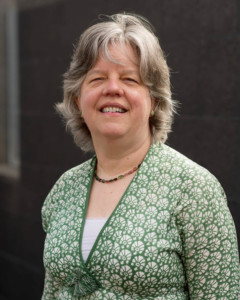
Kathleen James-Chakraborty is professor of art history at University College Dublin. She is currently also an Ailsa Mellon Bruce Senior Fellow at the Center for Advanced Study in the Visual Arts at the National Gallery of Art. Her books include Architecture since 1400 (Minnesota, 2014) and Modernism as Memory: Building Identity in the Federal Republic of Germany (Minnesota, 2016) as well as the edited collections Bauhaus Culture from Weimar to the Cold War (Minnesota, 2006) and India in Art in Ireland (Routledge, 2016). In 2021 she was been awarded a European Research Council Advanced Grant for a project entitled Expanding Agency: Women, Race, and the Global Dissemination of Modern Architecture.

Rahul Mehrotra is Professor of Urban Design and Planning and the John T. Dunlop Professor in Housing and Urbanization at the Graduate School of Design at Harvard University. He is the founder principal of RMA Architects which has studios in Mumbai and Boston. In 2018 RMA Architects were awarded the Venice Biennale juror’s ‘Special Mention’ for ‘three projects that address issues of Intimacy and empathy, gently diffusing social boundaries and hierarchies’. In 2012-2015, he led a Harvard University-wide research project with Professor Diana Eck, called The Kumbh Mela: Mapping the Ephemeral Mega City. This work was published as a book in 2014 and the research extended in 2017 in the form of a book titled Does Permanence Matter? Mehrotra’s also co – authored a book is titled Taj Mahal : Multiple Narratives which was published in Dec 2017. Mehrotra’s most recent books are titled Working in Mumbai (2020) and The Kinetic City and other essays ( 2021). The former a reflection on his practice evolved through its association with the city of Bombay/Mumbai. The second book presents Mehrotra’s writings over the last thirty years and illustrates his long-term engagement with and analysis of urbanism in India. This work has given rise to a new conceptualization of the city which Mehrotra calls the Kinetic City.
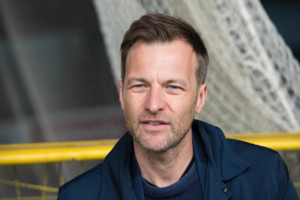
Martino Stierli is The Philip Johnson Chief Curator of Architecture and Design at the Museum of Modern Art, New York, a role he assumed in March 2015. Stierli oversees the wide-ranging program of special exhibitions, installations, and acquisitions of the Department of Architecture and Design. He is the author of Montage and the Metropolis: Architecture, Modernity and the Representation of Space (Yale University Press, 2018) and Las Vegas in the Rearview Mirror: The City in Theory, Photography, and Film (Getty Research Institute, 2013). He has organized and co-curated exhibitions on a variety of topics, including the international traveling exhibition Las Vegas Studio: Images from the Archives of Robert Venturi and Denise Scott Brown, and The Architecture of Hedonism: Three Villas in the Island of Capri, which was included in the 14th Architecture Biennale in Venice in 2014. At MoMA, he has curated the exhibitions Toward a Concrete Utopia: Architecture in Yugoslavia, 1948-1980 (with Vladimir Kulić), Renew, Reuse, Recycle: Recent Architecture from China (with Evangelos Kotsioris), and The Project of Independence: Architectures of Decolonization in South Asia, 1947-1985 (with Anoma Pieris and Sean Anderson). Stierli also oversaw the installation of the new Architecture and Design collection galleries in the expanded MoMA, which opened in October 2019, and curated numerous collection installations.


Anne Lacaton
| Event Information |
|---|
| The guest speaker for this event will be joining us virtually.
All are invited to watch and participate online in this program by tuning into this page at the noted start time. No pre-registration is required. Online audience members will be able to submit questions throughout the event using Vimeo’s Q&A function. If you would like to submit questions for the speaker in advance of the event, please click here. Harvard ID holders are also welcome to attend programs in person, except where an event is listed as online only. Live captioning will be provided during this event livestream. Learn more about accessibility services at public programs. |
This event recording is also available to watch with audio description.
Event Description
French architect Anne Lacaton will deliver the inaugural Jaqueline Tyrwhitt Urban Design Lecture. Lacaton and partner Jean-Philippe Vassal received the 2021 Pritzker Prize, architecture’s highest honor.
Audience members who attend this event in its entirety may be eligible for continuing education credits from AIA. Please reach out to [email protected] for more information.
Speaker
Anne Lacaton (1955, Saint-Pardoux, France) and Jean-Philippe Vassal met in the late 1970s during their formal architecture training at École Nationale Supérieure d’Architecture et de Paysage de Bordeaux. They established Lacaton & Vassal in Paris (1987), and have since demonstrated boldness through their design of new buildings and transformative projects. For over three decades, they have designed private and social housing, cultural and academic institutions, public space, and urban strategies. The duo’s architecture reflects their advocacy of social justice and sustainability, by prioritizing a generosity of space and freedom of use through economical and ecological materials.
Lacaton is an associate professor of Architecture and Design at the Swiss Federal Institute of Technology ETH Zurich (Zurich, Switzerland, since 2017), and a visiting professor at Polytechnic University of Madrid, Master in Housing (Madrid, Spain, since 2007). She has been a visiting professor at Delft University of Technology (Delft, Netherlands, 2016–2017) and Technische Hochschule Nürnberg Georg Simon Ohm (Nürnberg, Germany, 2014); was the Design Critic in Architecture (2015) and the Kenzo Tange Visiting Chair in Architecture and Urban Planning (2011) at Harvard Graduate School of Design (Cambridge, MA); and the Clarkson Chair at the University of Buffalo (Buffalo, NY, 2013). She served on the LafargeHolcim Awards jury for Europe (2017) and will be a member of the 2021 jury later this year.
Small Infrastructures
| Event Information |
|---|
| Please visit the UC Berkeley CED website for information on how to attend this event. |
To submit questions during the event, navigate to Slido.com and enter event code: #ARCHevent
Event Description
In March 2021, the Biden Administration released the American Jobs Plan, earmarking $213B for “quality” and “affordable” housing, yet the bill lacks specificity on how houses are to be built. Here housing’s problem is split into two: a social one of accessibility and equity, and a material one of wood, metal, and rocks. Architects can play a unique role in bridging abstract policy ambitions to real construction as these connections are made every day in practice.   
Although accessible housing has been cast in many forms, accessory dwelling units (ADUs) have been a catalyst for including architects in direct policy development. For the first time, cities are directly contracting with architects to provide designs for private property through pre-approved ADU programs. These programs reflect a plurality of ideas, though without rigorous consideration for how the costs of site work, labor, materials, and energy make quality housing sustainable.  
Small Infrastructures is an exhibition of ADU designs that uses the economics of building assembly as the groundwork for experimentation. Ten architects teaching at Harvard GSD and Berkeley CED consider the overlaps between academia, where cost is often external to conceptual work, and practice, where budgeting is an integral task. 
Curated by Michelle Chang and Rudabeh Pakravan 
Participants
- Lyndon Neri and Rossana Hu are Founding Partners of Neri&Hu Design and Research Office and John C. Portman Design Critics in Architecture at Harvard GSD.
- Sean Canty, MArch ’14, is an Assistant Professor of Architecture at Harvard GSD and the founder of Studio Sean Canty (SSC).
- Yasmin Vobis is co-founder of Ultramoderne and an Assistant Professor of Architecture at Harvard GSD.
- Andrew Atwood, MArch ’07, is an Associate Professor of Architecture at UC Berkeley and a partner in the architecture firm, First Office.
- Lisa Iwamoto MArch ’93 and Craig Scott MArch ’94 are partners at IwamotoScott Architecture. Lisa is Professor and Chair of Architecture at UC Berkeley College of Environmental Design (CED) and Craig is Professor at CCA.
- Mark Anderson, MArch ’86, is a Professor of Architecture and a partner in the firm Anderson Anderson Architecture. 
- Neyran Turan, DDes ’09, is an Associate Professor of Architecture at UC Berkeley CED and a founding partner at NEMESTUDIO. 
- Michelle Chang, MArch ’09, is an Assistant Professor of Architecture at Harvard GSD and the director of JaJa Co. 
- Rudabeh Pakravan is a Continuing Lecturer at UC Berkeley CED and a principal at Sidell Pakravan Architects. 


Mariam Kamara, “atelier masōmī: pedagogy, practice and (shifting) possibilities”
| Event Information |
|---|
| The guest speaker for this event will be joining us virtually.
All are invited to watch and participate online in this program by tuning into this page at the noted start time. No pre-registration is required. Online audience members will be able to submit questions throughout the event using Vimeo’s Q&A function. If you would like to submit questions for the speaker in advance of the event, please click here. Harvard ID holders are also welcome to attend programs in person, except where an event is listed as online only. Live captioning will be provided during this event livestream. Learn more about accessibility services at public programs. |
This event recording is also available to watch with audio description .
Event Description
The Architecture canon, the way it is researched, taught and practiced, has a singular point of view. Accepting that point of view as universally valid has been one of the biggest missed opportunities in architecture. What we are taught as universal masterworks are, in reality, only a representation of a small homogenous group. This talk will cover the way I have merged practice and research to fill the gaps left by the absence of authentic scholarship outside of the canon. I will also discuss the ways in which this approach continues to shift my conception of what is possible given the contexts, narratives, and challenges of the places in which we work.
Audience members who attend this event in its entirety may be eligible for continuing education credits from AIA. Please reach out to [email protected] for more information.
Speaker
Mariam Issoufou Kamara is an architect from Niger who studied architecture at the University of Washington. In 2014, she founded atelier masōmī , an architecture and research practice with offices in Niger’s capital, Niamey. The firm tackles public, cultural, residential, commercial, and urban design projects. Kamara believes that architects have an important role to play in creating spaces that have the power to elevate, dignify, and provide people with a better quality of life.

The Hikma Community Complex, designed by Kamara and Yasaman Esmaili, won the 2017 Gold LafargeHolcim Award for Africa and the Middle East, and the 2018 Silver Global LafargeHolcim Award for Sustainable Architecture. Other projects include the Dandaji Regional Market, which was shortlisted for the Dezeen Awards in 2019. Upcoming projects include an office building in Niamey as well as the Niamey Cultural Centre, which Kamara designed under the mentorship of Sir David Adjaye as part of the Rolex Mentor and Protégé Initiative.
In 2019, Kamara was named as a Laureate of the Price Claus Award. She was a 2019 Royal Academy of Arts Dorfman Awards finalist. The New York Times named her as one of 15 Creative Women of Our Time. The Royal Institute of Canada named her as one of their 2020 Honorary Fellows. The firm has appeared twice on the AD100 list.
Follow Mariam Kamara on Twitter and Instagram .
This event is part of International Womxn’s Week 2022, presented by Womxn in Design .
Anthony Titus, “Rupture and Reconciliations”
| Event Information |
|---|
| All are invited to watch and participate online in this program by tuning into this page at the noted start time. No pre-registration is required. Online audience members will be able to submit questions throughout the event using Vimeo’s Q&A function. If you would like to submit questions for the speaker in advance of the event, please click here.
Harvard ID holders are also welcome to attend programs in person, except where an event is listed as online only. Live captioning will be provided during this event livestream. Learn more about accessibility services at public programs. |
This event recording is also available to watch with audio description .
Event Description
The lecture will focus on the structure of Anthony Titus’s transdisciplinary practice of art and architecture. Titus will speak about a selection of several exhibitions, installations, and projects that span the past decade. Emphasis will be placed upon the processes and procedures as well as the final product of the works. Looking to explore and discover new possibilities between the spaces of architecture, sculpture, and painting Titus will share drawings, diagrams, models, and photographs of the projects. The conversation and exchange between these disciplines serves as a rich space of opportunity to enhance and expand our current understanding of space, form, color, and structure as participants in a larger cultural landscape.
Reference will be made to Titus’s architectural education at the Cooper Union for the Advancement of Science and Art, under the deanship of John Hejduk as well as his graduate education in painting at the University of Chicago. In addition to his independent studio work, Titus has served as an architectural educator for the past two decades and he will include a small selection of teaching work in dialogue with his studio practice.
Audience members who attend this event in its entirety may be eligible to receive continuing education credits from AIA. Please email [email protected] for more details.
Speaker
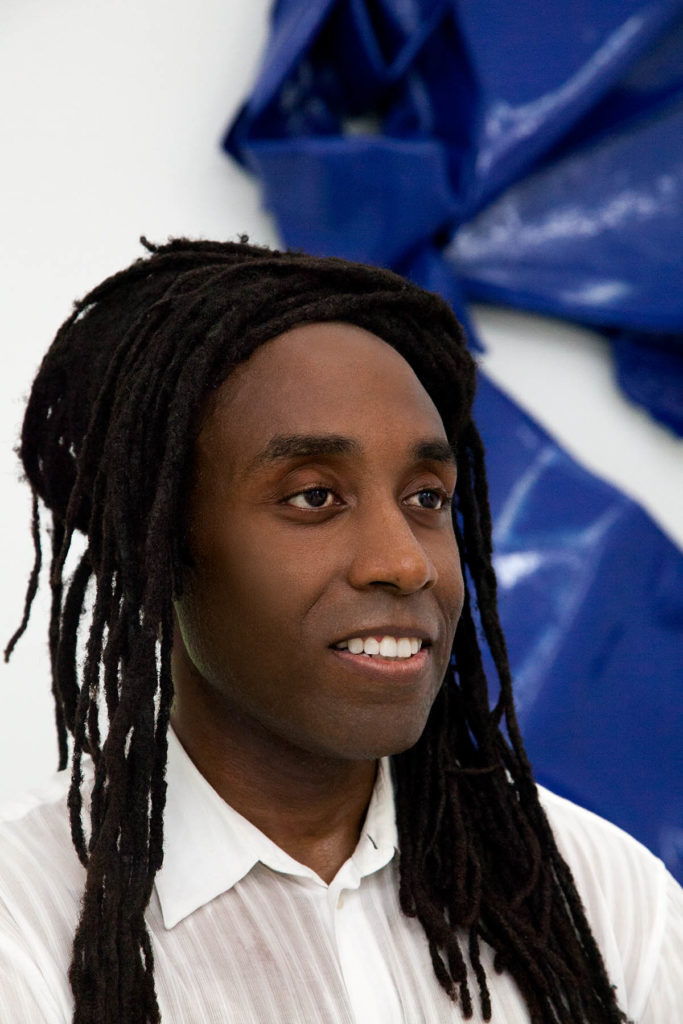
Anthony Titus Studio is an interdisciplinary practice that focuses on the relationships between contemporary art and architecture. Since its inception in 2005, the studio has produced numerous installations, objects as well as solo and group exhibitions in the United States and abroad. The practice has consistently explored the uniquely constructed spaces between architecture, painting and sculpture. Parallel to his independent practice, Titus has taught architecture and art since 2002. He is currently a tenured professor of architecture at Rensselaer Polytechnic Institute, and he is the recipient of a 2013 research grant from the Graham Foundation for Advanced Studies in the Fine Arts. The research project is titled Twisted Siblings: Relationships Between Contemporary Painting and Digital Architecture. His work has been exhibited and published widely and includes a current solo exhibition titled Ruptures and Reconciliations at ‘T’ Space in Rhinebeck, NY. He received his undergraduate degree in architecture from the Cooper Union for the Advancement of Science and Art, and a graduate degree in fine art from the University of Chicago.

